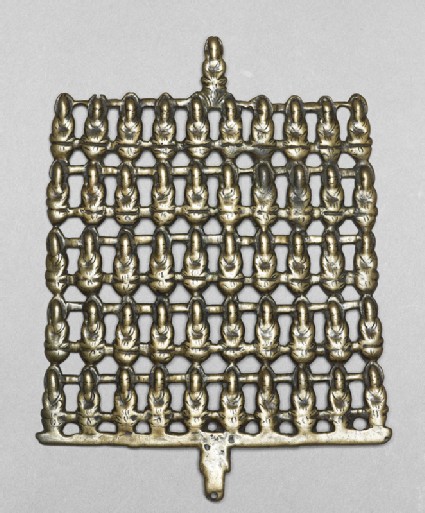Search Results: objects
Show search help- Reference URL
Actions
Plaque with fifty-one Buddhas
-
Details
- Associated place
-
Asia › Tibet › east Tibet (possible place of creation)Asia › China › Nanzhao Kingdom (possible place of creation)
- Date
- 8th - 9th century AD (AD 701 - 900)
- Material and technique
- bronze
- Dimensions
- 18.7 x 14.3 x 0.4 cm (height x width x depth)
- Material index
-
processed material › metal › alloy › copper alloy › bronze
- Technique index
- Object type index
- No. of items
- 1
- Credit line
- Purchased, 2001.
- Accession no.
- EA2001.153
-
Further reading
Heller, Amy, Early Himalayan Art (Oxford: Ashmolean Museum, 2008), no. 27 on p. 96, p. 24, illus. p. 97
Location
Objects are sometimes moved to a different location. Our object location data is usually updated on a monthly basis. Contact the Jameel Study Centre if you are planning to visit the museum to see a particular object on display, or would like to arrange an appointment to see an object in our reserve collections.
Publications online
-

Early Himalayan Art
All fifty-one seated Buddhas are identical in appearance. Their crown is now worn and they have rather round faces, within ovoid haloes. They are draped in a V-necked robe of a thick fabric, with the hands held within the over-long wide sleeves. The robe is belted at the waist, and the hands are joined below the waist. The Buddhas are seated in vajraparyanka asana, on a thin cushion above a lotus pedestal.
The arrangement of the Buddhas gives certain clues as to their hierarchy and identification. There is one Buddha completely isolated and elevated above the centre of the upper row. He is undoubtedly the sovereign figure, surrounded by five groups of ten assistants. This number may be an indication that they represent the Bodhisattvas who guard the ten bhumi, the ten fields of achievement. Their multiplication by five to make fifty attendants is probably to be understood figuratively as well as literally, in relation to the cardinal points and the centre. In other words, the Buddha is surrounded both by fifty attendants and by an infinite multitude of attendants. This type of composition of the Thousand Buddhas of the Fortunate Aeon is known in Tibetan art from the eleventh-century paintings at Tabo monastery, but it follows a much earlier model, known since the late fifth century in Indian wall- painting at Ajanta [1]. This iconography also spread along the Silk Road to China, where the Tibetans encountered it during their occupation of Dunhuang [2].
It is notable that the Buddhas in this plaque all have similar garments and the ovoid halo of the Beedo Buddha, created in 806 AD in Eastern Tibet [3]. At the same period, stone sculptures of royalty in northwest Yunnan are known in sanctuaries of the Nanzhao kingdom, in which the king wears very similar robes, with excessively wide sleeves and of a thick fabric [4]. Nanzhao at that time had a close relationship with Tibet, alternately as its ally or enemy. Thus one may suggest a provenance from either eastern Tibet or the Nanzhao kingdom region.
This plaque may be related to tokcha amulets, insofar as it is completely flat at the reverse and has a hole at the bottom for suspension or to attach a base. But if it was for suspension, there are also two corresponding holes at each end of the top row, next above the head of the last Buddha but one. One of these two holes is broken but the other is intact; it would also have been quite easy to suspend the plaque simply by using the spaces in between the Buddhas. Thus the bottom tang and hole must have been for attachment to some other object, possibly after the plaque was no longer used in rituals. It could perhaps have been inserted into a ritual cake called torma (gtorma), and thus secured through the weight and height of the plaque (which would moreover make it hard to attach to a bookcover, and impossible to wear on the body).
[Footnotes:]
1 Heller, Tibetan Art, pl. 28, for the wall of multiple Buddhas painted in the main Tabo sanctuary c. 1040 ad; Okada and Nou, Ajanta, pp. 146-9, for the wall-painting in Ajanta Cave 2.
2 For ninth-century examples of the Thousand Buddhas from Dunhuang, see Whitfield and Farrer, Caves of the Thousand Buddhas, pls. 80-1.
3 Heller, 'Early Ninth-century Images of Vairocana from Eastern Tibet', fig. 12.
4 Howard, 'The Development of Buddhist Sculpture in Yunnan', fig. 2, for the Audience of King Geluofeng, ninth century (also Heller, 'Early Ninth-century Images of Vairocana', fig. 15, for a detail of the portrait of King Geluofeng in stone, h. 137 cm, at Jianchuan, Yunnan).
Galleries
© 2013 University of Oxford - Ashmolean Museum




